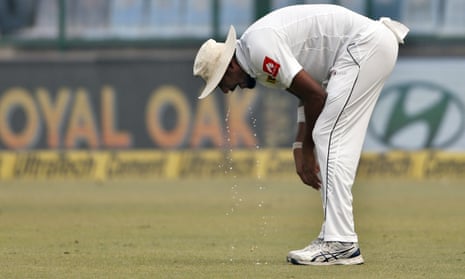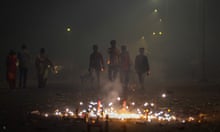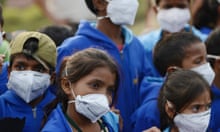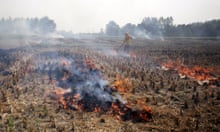A Sri Lankan player vomited on the field and was escorted off the ground as heavily polluted air continued to plague an international cricket test match in Delhi.
The fast bowler Suranga Lakmal was seen doubled over and retching on Tuesday afternoon as levels of the most harmful pollutants hovered at about 300 micrograms per cubic metre in parts of the Indian capital – 12 times the World Health Organisation safe limit.
Lakmal was one of the players to be badly affected on Sunday when air pollution forced a break in play in the test between India and Sri Lanka, the first such interruption in international cricket history. He and another bowler, Lahiru Gamage, were forced to abandon bowling duties mid-over for a spell in the changing rooms where the coach, Nic Pothas, said Lakmal was “continuously vomiting”.
Lakmal was helped off the ground on Tuesday by a Sri Lankan team physiotherapist after his team-mates – mostly playing in pollution masks – rushed to his aid. Later the Indian pacer Mohammed Shami also vomited. Groundsmen scattered sawdust.
The scenes at Feroz Shah Kotla stadium have fuelled a debate in India over whether Delhi should be permitted to hold sporting events during winter when year-round pollution in the city reaches severe levels.
The Indian cricket board said on Monday that in future it would consider amending its schedules based on pollution forecasts.
“Scheduling of matches in Delhi during this time of the year will be considered,” said Amitabh Chaudhary, the acting secretary of the Board of Control for Cricket in India.
The acting president of the board, CK Khanna, had earlier dismissed concerns, saying: “If 20,000 people in the stands did not have problems and the Indian team did not face any issue ... the Sri Lankan team made a big fuss?”
Javier Ceppi, the director of the Fifa under-17 World Cup held in India in October, wrote on Twitter after Sunday’s incidents that Delhi could not host sporting events from Diwali until the end of February “at least”.
You can't host sport events in Delhi from Diwali till end of Feb, at least. It is a fact. We had to accommodate our whole schedule to avoid it and others should also think about athletes health first #DelhiSmog
— Javier Ceppi (@JavierCeppi) December 3, 2017
The Indian Medical Association also condemned the decision to let the Delhi test go ahead. “You have fast bowlers, batsmen and fielders out there exposed to these very harmful pollutants over five days at a stretch. It takes a serious toll on your health in the long run,” said the association’s president, KK Aggarwal.
Indian players and the match umpires have almost all eschewed masks throughout the test and some fans accused the Sri Lankans of grandstanding, pointing out that India’s captain, Virat Kohli, posted a record double-century despite the conditions.
The atmosphere in Delhi is dense with carcinogenic chemicals fine enough to lodge deep in the lungs and breach the blood-brain barrier. Multiple studies have linked the pollution to higher rates of lung cancer, heart disease and chronic respiratory conditions in the long-term, while immediate exposure can trigger asthma attacks and cause discomfort to the eyes and throat.
Indian environmental authorities said pollution levels last year exceeded those recorded during the 1952 great smog of London, considered one of Britain’s worst environmental disasters.
Contributors to the poor air in the city include road dust, open fires, vehicle exhaust fumes, industrial emissions and the burning of crop waste in neighbouring states, all of which worsen in winter when winds slow and air is trapped closer to the ground.
Delhi and surrounding states have implemented separate action plans that are unevenly enforced. A lasting solution would require national coordination while simultaneously tackling the myriad sources of poor air, a challenging task in a country with generally limited law enforcement.








